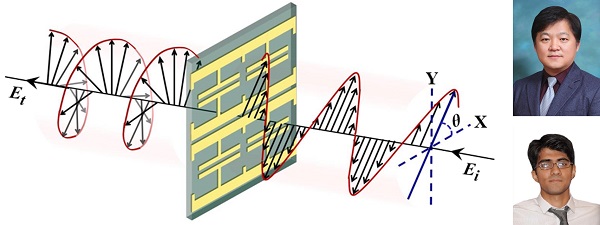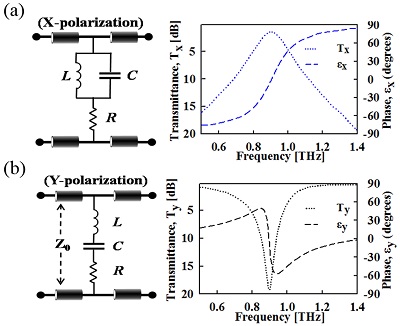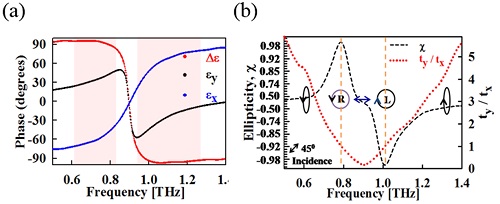Media Center
A multimedia mosaic of moments at GIST
GIST Excellence
[Press Release] Professor Jae-Hyung Jang"s research team has developed terahertz wave polarization conversion technology using meta-material
- 엘리스 리
- REG_DATE : 2016.12.19
- HIT : 916
Professor Jae-Hyung Jang"s research team has developed terahertz wave polarization conversion technology using meta-material

[Figure 1] Diagram of terahertz polarization converter operation based on meta-material. The terahertz incident wave (right Ei) of linearly polarized light is converted into a terahertz transmission wave (left Et) of circularly polarized light while transmitted through the terahertz polarizing element based on the meta-material.
Techniques have been developed to convert the polarization of terahertz waves * using a hybrid metamaterial *. This technology is expected to accelerate the practical use of video and wireless communication technologies in the terahertz waveband.
Metamaterials: artificial materials that have a dielectric or metal resonator structure that are much smaller than the wavelength of the electromagnetic wave and that periodically arrange the structure to realize unique properties that do not exist in nature
Terahertz wave: An electromagnetic wave having a frequency of 1 trillion (1012) times per second. Image and analysis techniques using terahertz waves, which are used for pathological tissue diagnosis, explosives and drug detection, are considered to be promising technologies in the future.
* Polarization: The phenomenon of when the electric field or magnetic field of electromagnetic wave oscillates in a specific direction
∘ Gwangju Institute of Science and Technology (GIST) Professor Jae-Hyung Jang of the School of Electrical Engineering and Computer Science has devised a hybrid metamaterial that resonates in opposite direction according to the polarization direction of the terahertz wave. The metamaterial succeeded in converting linearly polarized terahertz waves into circularly polarized terahertz waves with high efficiency in wideband.
□ Terahertz waves have superior permeability and are harmless to human body, so they can be applied to next-generation biomedical imaging technology for cancer diagnosis and can replace x-rays at airports. It can also be used for high-speed wireless communication technology utilizing high frequencies. This requires a technique for freely controlling polarization, which is one of the properties of electromagnetic waves.
However, because terahertz waves have low energy and direct control of electromagnetic waves using a semiconductor material is difficult, research on using artificial meta-materials to control them are under way.

[Figure 2] Equivalent circuit model for the polarization direction of incident wave and complementary measurement results. (A) A graph of the equivalent circuit model for the X-direction polarization and a graph of the bandpass transmittance and phase change according to the frequency. (B) A graph of the band erase transmittance and phase change according to the equivalent circuit model and frequency.

[Figure 3] Graph of operational characteristics of a fabricated polarization converter. (A) A graph of a polarization conversion characteristic complementary to a polarization direction; and (b) equivalent circuit model for Y - directional polarization and graph of band erasure transmission and phase change according to frequency.
The team first implemented a hybrid metamaterial on a flexible, ultra-thin substrate. This meta-material is designed to exhibit band-pass characteristics in one direction (X direction) and LC-band resonance characteristics in LC direction (direction Y).
* LC-Resonator: This is a connection circuit between an inductor and a capacitor. It exhibits resonance at a specific frequency.
∘ This metamaterial resonates in the opposite direction according to the polarization direction of the terahertz wave, resulting in a phase difference of 90 ° between the terahertz wave in the X direction and the terahertz wave in the Y direction (see Figure 2).
∘ The team confirmed that a low insertion loss of 4 to 10 dB * was seen at 0.64 to 0.82 THz and a broadband of 0.96 to 1.3 THz, and successfully converted the terahertz wave polarized wave with an ideal ellipticity * of 0.997. (See Figure 3)
* Insertion loss: loss caused by inserting an object into the transmission path of a signal
* Ellipticity: A measure of the closeness to an ideal circle. The closer to 1, the closer to a perfect circle.
Applying the team"s technology is expected to accelerate the commercialization of a miniaturized terahertz wave based systems by replacing existing terahertz polarization transducers based on large bulk optics *.
* Bulk optics: Optical with three-dimensional volume components such as mirrors and lenses. The disadvantage is that signal loss is large, and it is difficult to downsize the system.
Professor Jae-Hyung Jang said, "For most terahertz signal sources, terahertz waves of linear polarization are the output. However, in the field of image and spectroscopic technology, terahertz sources of circular polarizations are often needed. We plan to implement a terahertz source of circular polarization through integration with the terahertz signal source. "
□ The research was conducted by Professor Jae-Hyung Jang (corresponding author) and by Ph.D. student Muhammad Tayyab Nouman (first author) and was carried out with the support of Samsung Electronics Future Technology Development Project. Their paper was published on December 13, 2016, in Scientific Reports.